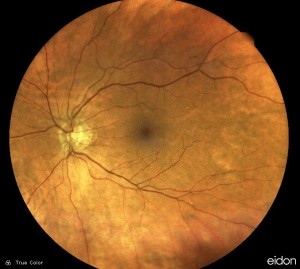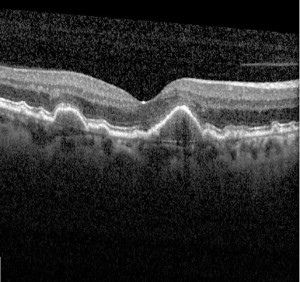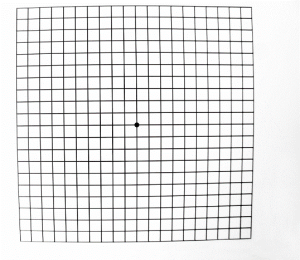Age-related macular degeneration (ARMD): The macula truths
Age-related macular degeneration (ARMD) is one of these ‘somethings’. It is a disease in which the macula begins to have trouble breaking down waste products. This results in a build-up of deposits and causes the ongoing, increasing distortion of central vision.
When you are looking directly at something, you are using your macula. If something was to happen to the macula, the central part of your vision may become affected.
One of the most common questions eye practitioners are asked at the end of an eye exam is ‘do I have macula??!’ Get ready for the big truth: everyone has macula! The macula is simply (actually it’s very complex!) the central part of the back of your eye, or retina, which has the highest density of cells that help you see the world around you.
If you have mild macular degeneration, when you look at a straight line, you are likely to see a bend in the line. If your macular degeneration is more severe, you may be unable to see people’s faces when you are looking directly at them.
Read on to find out more about ARMD and – more importantly – how to avoid or treat it!

Simulation of vision loss from ARMD
What is dry ARMD?
Dry macular degeneration is just as it sounds – the changes are dry, meaning there is no fluid build-up at the macula. While there is no current treatment for dry macular degeneration, this form of the disease progresses more slowly, causing gradual loss of vision and distortion of central vision.
But slow doesn’t mean less risk! Everyone who develops ARMD will start out with dry changes. Unfortunately, a proportion of those with dry ARMD will develop a membrane in their eye, which will begin to leak…and – lo and behold – ‘dry’ becomes ‘wet’.
- A retinal photo showing a normal macula
- An Example of Dry AMRD
- An OCT scan showing a normal macula
- An OCT scan showing dry ARMD
What is wet ARMD?
In simple terms, wet macular degeneration means there is fluid leakage at the macula. This is usually due to the eye developing membranes made of leaky vessels that cause bleeds. Doesn’t sound fun, does it?!
A haemorrhage at the macula will usually cause a rapid deterioration in vision and sudden distortion of central vision. Ultimately it will require treatment as soon as possible.
The current treatment for wet ARMD is (brace yourself – it sounds scary!) injections in the eye. These are often required four weeks apart initially, then become less frequent as vision improves and stabilises. The injections deliver a medicine to the back of the eye which helps to dry out the leaking fluid.
Most people who are treated with injections for macular degeneration will agree that they are not as daunting as they may sound. Anaesthetic is used to numb the eye prior to the injections and they are given away from your line of vision, so you can’t feel the injection, or see it directly coming towards you.
Whether you’re living with wet or dry ARMD, taking supplements with antioxidants, Vitamin C and Vitamin E can also help slow the progression of the disease.
- An example of wet ARMD with macula haemorrhaging
- …the same eye following 5 injections!
- An OCT scan showing wet ARMD
- …The same following 5 injections!
How do I Know which Type I Have?
Ocular Coherence Tomography (OCT) scans are used to diagnose ARMD and differentiate between the types. This is a test similar to an ultrasound but uses a special wavelength of light in the near-infrared spectrum. It tells us whether there is fluid build-up at the back of the eye, or if the changes are dry. At KindSIGHT we are fortunate to offer our patients OCT scanning with the Heidelberg Spectralis, the ‘Rolls Royce’ of OCT scan technology, which is able to detect very fine abnormalities at the macula and monitor extremely closely for subtle changes.
The Amsler Grid
Because dry ARMD could transform to wet ARMD at any time, if you have ARMD, keeping a close eye (pardon the pun) on your vision is very important. You should also ensure you see an eye health professional regularly to pick up any further degeneration and commence treatment as soon as possible where required.
An Amsler grid is an important tool when it comes to monitoring ARMD. This little gem is a square set of gridlines that patients with ARMD are advised to use on a daily basis to check for signs of distortion. Noticing rapid changes on an Amsler grid could be an indication that you are developing a bleed at the macula.
Hence, for those who have been diagnosed with ARMD, it is essential in detecting changes in their condition. But moreso, EVERYONE should use an Amsler grid regularly to check for any new signs which could be an indication that something is not quite right at the macula!
- An Amsler Grid as seen by a patient with a normal macula
- An Amsler Grid as seen by a patient with ARMD
Are the Seasons Changing for Wet and Dry ARMD?
New research is currently being conducted to investigate the use of stem cells in the treatment of both wet and dry macular degeneration. In other exciting new developments, a dissolvable implant is being trialed to treat wet macular degeneration. This would mean patients no longer have to undergo monthly injections – hip, hip hooray!
Top tips for avoiding macular degeneration
- Avoid smoking – smoking increases your risk of developing macular degeneration by three to four times
- Maintain a healthy weight
- Exercise regularly
- Eat a healthy, well-balanced diet, including:
- Oily fish such as salmon, sardines, mackerel, herring and trout
- Dark green leafy vegetables such as kale, silverbeet and spinach
- Yellow vegetables including pumpkin and corn
- Vitamin C and Vitamin E
- Carbohydrates that have a low glycaemic index (GI)
- Low saturated fats.
If you have noticed a change in your vision, or distortion of your central vision, contact us for a consultation to have your macula checked today!












